
The peppered moth is a temperate species of night-flying moth. It is mostly found in the northern hemisphere in places like Asia, Europe and North America. Peppered moth evolution is an example of population genetics and natural selection.

Butterflies are winged insects from the lepidopteran suborder Rhopalocera, characterized by large, often brightly coloured wings that often fold together when at rest, and a conspicuous, fluttering flight. The group comprises the superfamilies Hedyloidea and Papilionoidea. The oldest butterfly fossils have been dated to the Paleocene, about 56 million years ago, though they may have originated earlier.

Lepidoptera or lepidopterans is an order of winged insects that includes butterflies and moths. About 180,000 species of the Lepidoptera have been described, representing 10% of the total described species of living organisms, making it the second largest insect order with 126 families and 46 superfamilies. and one of the most widespread and widely recognizable insect orders in the world.

The Noctuidae, commonly known as owlet moths, cutworms or armyworms, are a family of moths. They are considered the most controversial family in the superfamily Noctuoidea because many of the clades are constantly changing, along with the other families of the Noctuoidea. It was considered the largest family in Lepidoptera for a long time, but after regrouping Lymantriinae, Catocalinae and Calpinae within the family Erebidae, the latter holds this title now. Currently, Noctuidae is the second largest family in Noctuoidea, with about 1,089 genera and 11,772 species. This classification is still contingent, as more changes continue to appear between Noctuidae and Erebidae.

The luna moth, also called the American moon moth, is a Nearctic moth in the family Saturniidae, subfamily Saturniinae, a group commonly named the giant silk moths.

Skippers are a group of butterflies placed in the family Hesperiidae within the order Lepidoptera. They were previously placed in a separate superfamily, Hesperioidea; however, the most recent taxonomy places the family in the superfamily Papilionoidea, the butterflies. They are named for their quick, darting flight habits. Most have their antenna tips modified into narrow, hook-like projections. Moreover, skippers mostly have an absence of wing-coupling structure available in most moths. More than 3500 species of skippers are recognized, and they occur worldwide, but with the greatest diversity in the Neotropical regions of Central and South America.

The Arctiinae are a large and diverse subfamily of moths with around 11,000 species found all over the world, including 6,000 neotropical species. This subfamily includes the groups commonly known as tiger moths, which usually have bright colours, footmen, which are usually much drabber, lichen moths, and wasp moths. Many species have "hairy" caterpillars that are popularly known as woolly bears or woolly worms. The scientific name Arctiinae refers to this hairiness. Some species within the Arctiinae have the word "tussock"' in their common names because they have been misidentified as members of the Lymantriinae subfamily based on the characteristics of the larvae.

The Pyralidae, commonly called pyralid moths, snout moths or grass moths, are a family of Lepidoptera in the ditrysian superfamily Pyraloidea. In many classifications, the grass moths (Crambidae) are included in the Pyralidae as a subfamily, making the combined group one of the largest families in the Lepidoptera. The latest review by Eugene G. Munroe and Maria Alma Solis retain the Crambidae as a full family of Pyraloidea.

The Hepialidae are a family of insects in the lepidopteran order. Moths of this family are often referred to as swift moths or ghost moths.

The brown-tail moth is a moth of the family Erebidae. It is native to Europe, neighboring countries in Asia, and the north coast of Africa. Descriptions of outbreaks, i.e., large population increases of several years duration, have been reported as far back as the 1500s. The life cycle of the moth is atypical, in that it spends approximately nine months as larvae (caterpillars), leaving about one month each for pupae, imagos and eggs. Larvae (caterpillars) are covered in hairs. Two red spots on the back, toward the tail, distinguish these species from other similarly hairy moth larvae. The winged adults have white wings and a hairy white body with a tuft of brown hair at the tip of the abdomen. Females lay one egg cluster, usually on the underside of a leaf of a host plant. The species is polyphagous, meaning that it feeds on many different species of trees, including pear, apple, maple and oak.

Pterophorus pentadactyla, commonly known as the white plume moth, is a moth in the family Pterophoridae. It is found in the West Palearctic including North Africa and Europe. The wingspan is 26–34 mm (1.0–1.3 in). It is uniformly white, with the hind wing pair divided in three feathery plumes and the front pair in another two. The moths fly from June to August. The larvae feed on bindweed.
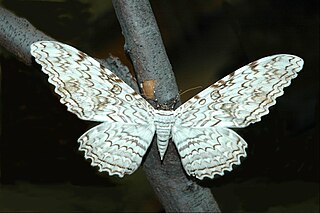
Thysania agrippina is a species of moth in the family Erebidae. It was described by Maria Sibylla Merian in her 1705 publication Metamorphosis insectorum Surinamensium, and Pieter Cramer provided the formal description of the species in 1776. The most commonly accepted English name is the white witch. Other common names include the ghost moth, great gray witch and great owlet moth. Thysania agrippina is of interest as a competitor for title of "largest insect". This may be true by the measure of wingspan—a Brazilian specimen with a wingspan of almost 30 cm (12 in) appears to hold the record. The Atlas moth and Hercules moth, however, have greater wing areas. The white witch occurs from Uruguay to Mexico, and appears as a stray as far north as Texas in the U.S. Collection dates shows no discernible pattern with respect to location or season.

Carposinidae, the "fruitworm moths", is a family of insects in the order Lepidoptera. These moths are narrower winged than Copromorphidae, with less rounded forewing tips. Males often have conspicuous patches of scales on either surface. The mouthparts are quite diagnostic, usually with prominent, upcurved "labial palps", the third segment long, and the second segment covered in large scales. Unlike Copromorphidae, the "M2" and sometimes "M1" vein on the hindwings is absent. The relationship of Carposinidae relative to Copromorphidae needs further investigation. It is considered possible that the family is artificial, being nested within Copromorphidae. The Palearctic species have been revised by Alexey Diakonoff (1989).

Copromorphidae, the "tropical fruitworm moths", is a family of insects in the lepidopteran order. These moths have broad, rounded forewings, and well-camouflaged scale patterns. Unlike Carposinidae the mouthparts include "labial palps" with the second rather than third segment the longest. With other unusual structural characteristics of the caterpillar and adult, it could represent the sister lineage of all other extant members of this superfamily. The genus Sisyroxena from Madagascar is also notable for its unusual venation and wing scale sockets.
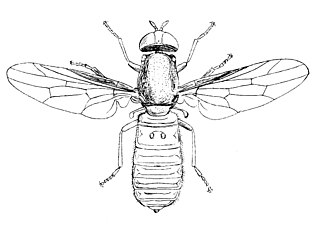
The Scenopinidae or window flies are a small family of flies (Diptera), distributed worldwide. In buildings, they are often taken at windows, hence the common name window flies.
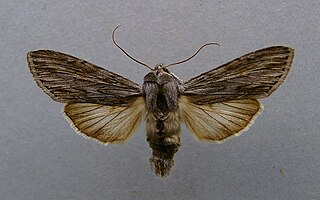
Cucullia lucifuga is a species of moth of the family Noctuidae. It is found in north, central and southern Europe east to Japan. It is also present in Tibet and Armenia.
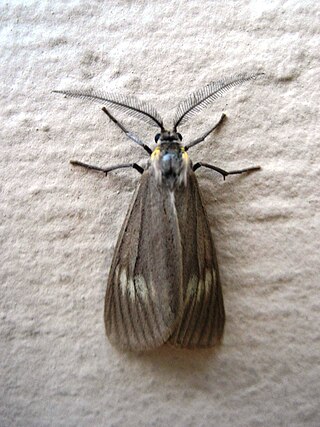
Phryganidia californica, the California oakworm or California oak moth, is a moth of the family Notodontidae. The species was first described by Alpheus Spring Packard in 1864. It is found along the coasts of the US states of California and Oregon.

Ancylis comptana, the strawberry leaf-roller or Comptan's ancylis moth, is a moth of the family Tortricidae. It is found from the United Kingdom and Scandinavia to northern Spain and Turkey, Asia Minor, Kazakhstan, Uzbekistan, Russia, China, Mongolia, Korea and Japan. In North America, it is represented by ssp. fragariae.

Micropterix tunbergella is a moth of the family Micropterigidae found in most of Europe. The moths are very small and can be found feeding on the pollen of hawthorn, oak and sycamore. The larva and pupa are unknown. The moth was described Johan Christian Fabricius in 1787.
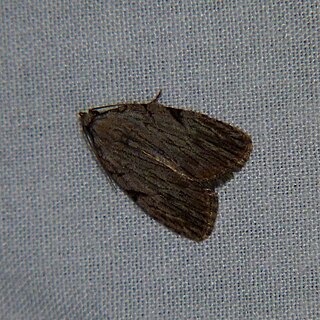
The three-lined balsa moth is a species of moth of the family Noctuidae. It is found in eastern North America.




















